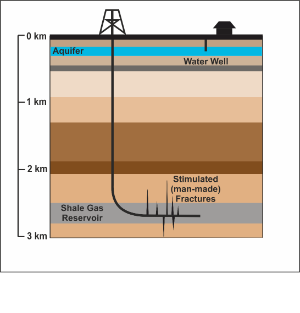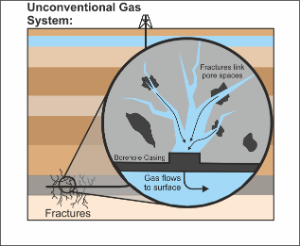What is Fracking?
From Britain to Bulgaria, Ukraine to the USA, shale gas and fracking seem to be constantly in the news. But what are shales, why do they contain gas, and what is the fracking process? Based in the UK, and led by the Newcastle and Durham Universities, the ReFINE project is using scientific research to investigate the impacts of shale gas development around the world. This guide provides an introduction to the topic and explains some of the key terms.
What is shale?
Shale is a mudstone, a sedimentary rock formed by layers of mud accumulating over millions of years and slowly being squeezed and compressed into stone. Mudstones are very common in the rock record, which is not surprising, since mud is the most common sediment on Earth. It covers most of the present-day sea floor and much of the land.
Muds and mudstones are composed of four main components: clay (tiny, flat mineral particles), quartz silt (small pieces of this common, tough mineral), carbon-rich organic matter (the broken-down bodies of plants and animals), and calcium carbonate (lime, often from shells). These occur in different ratios in different mudstones, but geologists often give the name shale to clay- and organic matter-rich mudstones that split into thin layers.
A Jurassic shale from Dorset, UK. Shales near Edale, Derbyshire, UK.
What is shale gas?
Particles of natural gas, typically methane, are often trapped in the pores of mudstones. If the quantity of trapped gas is high enough, and the succession of gas-bearing shale beds is thick enough, it can be economically viable to extract the gas for use as a fossil fuel or chemical feedstock. This is shale gas.
Why do shales contain gas?
Not all shales contain gas. They need to have formed from muds that had a high quantity of organic matter in them. When such muds get buried, compressed and heated, the organic matter is ‘cooked’ and broken down, and gas is released. This typically requires temperatures of at least 100°C (212°F), which normally occur 3 km or more below the Earth’s surface. Once the gas is generated, some of it will migrate up towards the surface, but much will remain trapped in pores in the shale. This trapped gas forms a shale gas reservoir, which is the target of exploration.
What is fracking?
“Fracking” is a short term for hydraulic fracturing. Hydraulic fractures can form naturally when pressurized fluids escape from deeply buried rocks and fracture them as they travel upwards. However, “fracking” is the process in which fractures are created intentionally by the injection of high-pressure fluids in order to release trapped natural gas. These man-made cracks are kept open by proppants such as sand.
Why is fracking used to extract shale gas?
Shales are porous, containing many tiny pores within which natural gas can be trapped. However, these pores are not interconnected, meaning that shales have very low permeability. As such, the gas will not flow through the rock. To release it, permeability must be created by hydraulically fracturing the shales. The thin, fluid-filled cracks produced by fracking enable the pores in the shale to become connected, and for the gas to flow out of the rock and into the well.









